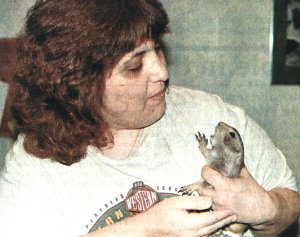

KERRI SANDS holds Dakota, a 3-and-a-half-month old prairie dog.
MISCHIEF, an almost 4-year-old prairie dog, looks in his cage.
Prairie dogs make great pets for those willing to give them the proper attention and care.
(These photos are scanned from the paper - Originals have been ordered and these will be replaced!)
Dogs of the prairie
Some consider them 'varmints', but Sands loves them anyway
For Kerri Sands, it was love at first site.
"I was living in Seattle at the time" said the Centennial Drive resident, "and I went into a pet shop looking for something. In the window they had some prairie dogs and I started playing with them. I just fell in love right there."
Sands had them put one of the furry little rodens on layaway until pay day, and two weeks later she picked up her first prairie dog whom she named "Mischief."
That was three and a half years ago and now Sands is an authority * on the little animals most of us have only heard about. In addition to Mischief, she recently aquired a 3-month-old prairie dog she's named "Dakota." Both are males. Mischief has been neutered and Dakota either has been or will be when the proper time comes.
"They get along just great," said Sands, putting Dakota in the cage with Mischief. "And they're such friendly, fun-loving little animals if you'll take the time to fool with them - and I do."
A self-proclaimed "Internet junkie", Sands has "met" many others who have prairie dogs for pets. Why Mischief even has his own site on the web.
Often considered the "scourge of the west," prairie dogs have a bad reputation in our plains states. Their burrows, some of which go more than 20 feet into the ground, are considered dangerous to grazing animals like horses, cattle and sheep. Farmers have thought them to be "competitors" for forage crops and in many places they've suffered from wholesale elimination.
At the turn of the century, there were seven species of prairie dogs. Today two of those species are extinct and two of the remaining five are on the endangered species list. **
Sands considers that a tragedy.
"These are such nice little animals," she says, giving Mischief a special treat. "And they're part of the natural food chain which will be disrupted if they are eliminated. People out west see them as varmints, just pesky little rodents."
Few people have been successful breeding prairie dogs in captivity, so most of those offered for sale were captured in the wild. And as it is with any wild animal, they require special care and attention.
"They're not pets for everyone," said Sands. "You really can't leave them unattended in the house like you can a cat or a dog. They'll chew anything they can get their teeth into from the couch to electric cords."
Sands has three cats and, she says, they get along well with the prairie dogs.
While they must stay confined when not being supervised, prairie dogs demand attention.
"They don't just require it," Sands says, laughing, "they demand it!"
Sands talks to her pet, holds him, and scratches his chin. She says when you're not paying enough attention he'll let you know by "standing" and sometimes chattering at you.
Sands says she's always loved animals - all kinds of animals.
"When I was a kid I'd find a bird that had fallen from the nest and bring him home. I'd ask my parents if I could keep him, not knowing he wouldn't make it anyway."
Sands is hoping that by raising awareness of prairie dogs as pets others might consider taking one or more into their homes.
"I know people from out west think I'm crazy having these 'varmints' in my home ***, but they're so friendly and loving. They're just great.
"I've just fallen in love with them."
If you'd like to "visit" Mischief on the Internet,
his address is http://geocities.datacellar.net/mischief_pd ****.
His email address is mischief@reliable-net.net.

Philip Case - State Journal Columnist
Mr. Case wrote this article which appeared in the Frankfort State Journal on
October 5, 1998
Photos courtesy of Frankfort State Journal photographer, Susan Riddell.
This article was prepared for the WWW by Kerri Sands, with permission from Philip Case, Frankfort State Journal.
* This is not a term I used in the interview. I am guessing Mr. Case inferred this from our conversation.
** The preceeding two paragraphs contain information taken from Prairie Dog Pets, written by Pat Storer.
*** This comment refers to some of the people from Colorado that I worked with while employed by FEMA (April - June 1998).
It is not meant to be derogatory in any way...but some of them really did think I was crazy!!! LOL
**** Mischief's web page URL was written incorrectly in the article, but a correction will be made in the paper on 10/6/98 by Mr. Case.
Main Page
What's New |
Story Corner |
Prairie Dog Central
Special Places |
Yips Galore |
Stuffeth!
View Guestbook |
Sign Guestbook
Email Mischief
Copyright certificate available upon request.
All graphics, content, design and layout
© 1996-2000 Mischief Creations/Kerri Sands


